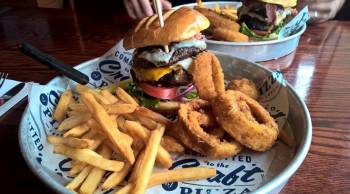A study out today suggests posting calorie information at fast food restaurants might not accomplish a damn thing.
The study’s being published online at Health Affairs. This is a hot topic, as several cities have enacted calorie-labeling laws, and a measure in the health care reform bill would require chain restaurants with 20 or more locations to post calorie info.
In the study, researchers interviewed people outside fast food joints in New York, shortly after the city’s new law took effect. From the New York Times:
(They) found that about half the customers noticed the calorie counts, which were prominently posted on menu boards. About 28 percent of those who noticed them said the information had influenced their ordering, and 9 out of 10 of those said they had made healthier choices as a result.
But when the researchers checked receipts afterward, they found that people had, in fact, ordered slightly more calories than the typical customer had before the labeling law went into effect, in July 2008.
They ordered more calories. Now, this wasn’t long after the law took effect. But the researchers’ conclusion?
“I think it does show us that labels are not enough,” Brian Elbel, an assistant professor at the New York University School of Medicine and the lead author of the study, said in an interview.
Is that what it shows? Researchers interviewed exclusively in low-income neighborhoods. The Times caught up with a few people in the same areas:
William Mitchell, from Rosedale, Queens, who was in Harlem for a job interview, ordered two cheeseburgers, about 600 calories total, for $2.
When asked if he had checked the calories, he said: “It’s just cheap, so I buy it. I’m looking for the cheapest meal I can.”
Tameika Coates, 28, who works in the gift shop at St. Patrick’s Cathedral, ordered a Big Mac, 540 calories, with a large fries, 500 calories, and a large Sprite, 310 calories.
“I don’t really care too much,” Ms. Coates said. “I know I shouldn’t, ’cause I’m too big already,” she added with a laugh.
Perhaps for low-income people, price trumps all. Or maybe posting calories makes things worse? From Associated Press:
The plan could backfire, said Stacey Rosenfeld, a New York psychologist who specializes in eating disorders. If you don’t order what you want because it’s high in calories, you might become dissatisfied and overeat later, she said.
Jessica Setnick, a Dallas-based dietitian who works with children and teens to address weight and eating issues, points out that nutrition information has been out there for years on packaged foods.
“People either think it doesn’t apply to them — these people still won’t care — or they are overly preoccupied with calories and fat grams and focus too much on the insignificant data,” she said. “The people in the middle, who eat appropriate amounts of a wide variety of foods, don’t need nutrition information on a menu to guide them.”
I’d put myself in that group, but I still like having the information. I’m sure there are people who could use more education about healthy eating, but you can’t shove broccoli in their mouths. And it’s not clear that even if you did, they would chew it. They might just spit it out and order a box of fries.
New York already has an ad campaign about daily calorie intake. And it’s making restaurants post the information. What “more” is there to do?
There’s a lot happening in the world. Through it all, Marketplace is here for you.
You rely on Marketplace to break down the world’s events and tell you how it affects you in a fact-based, approachable way. We rely on your financial support to keep making that possible.
Your donation today powers the independent journalism that you rely on. For just $5/month, you can help sustain Marketplace so we can keep reporting on the things that matter to you.


















